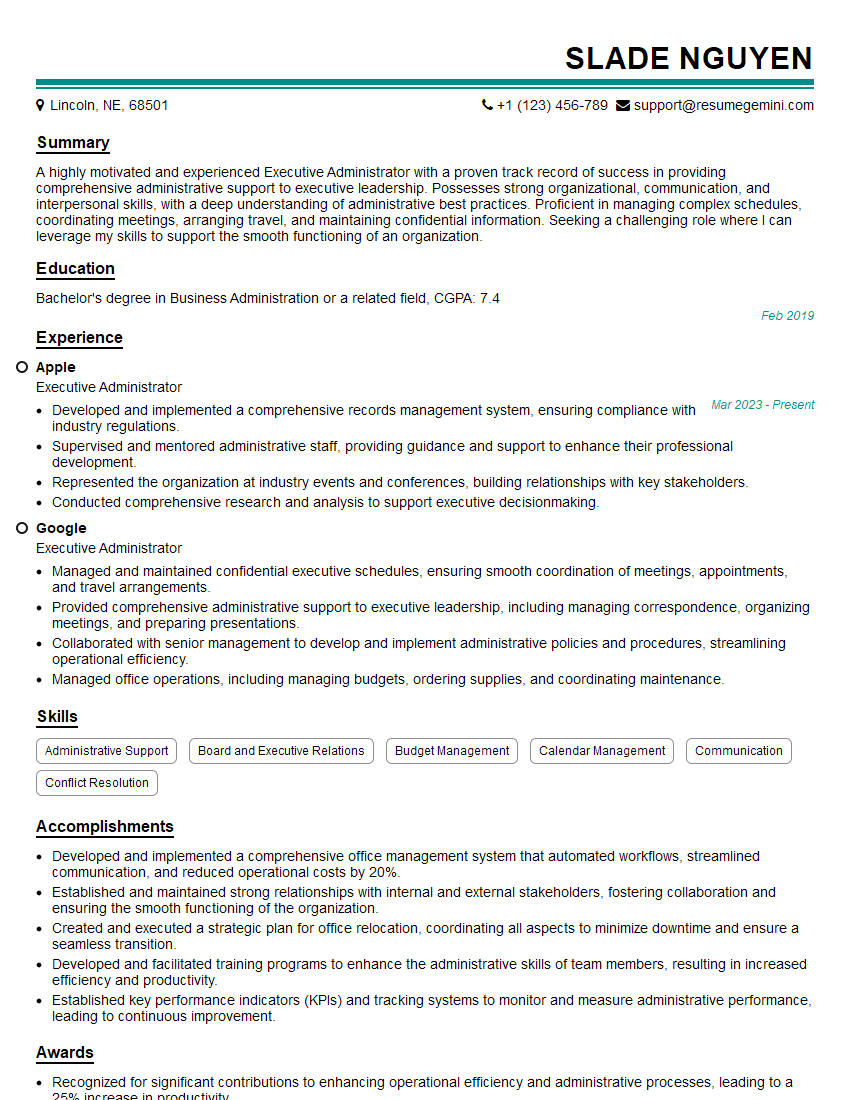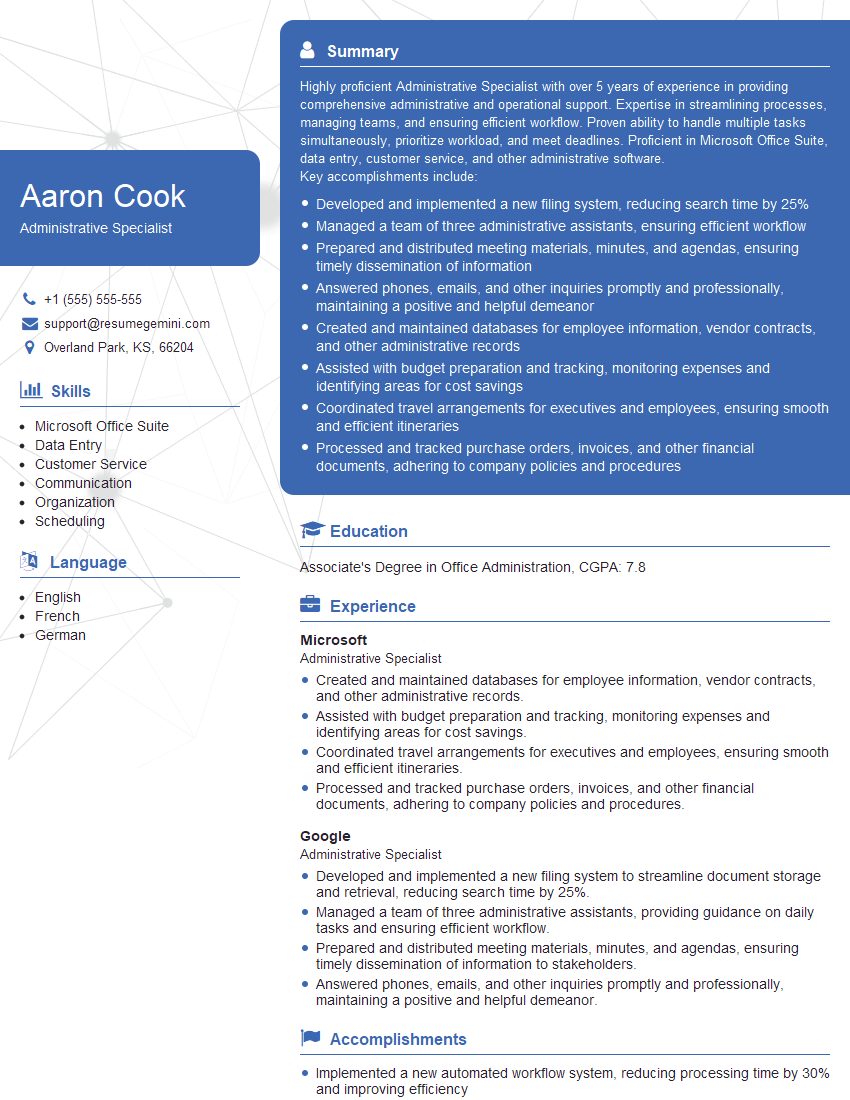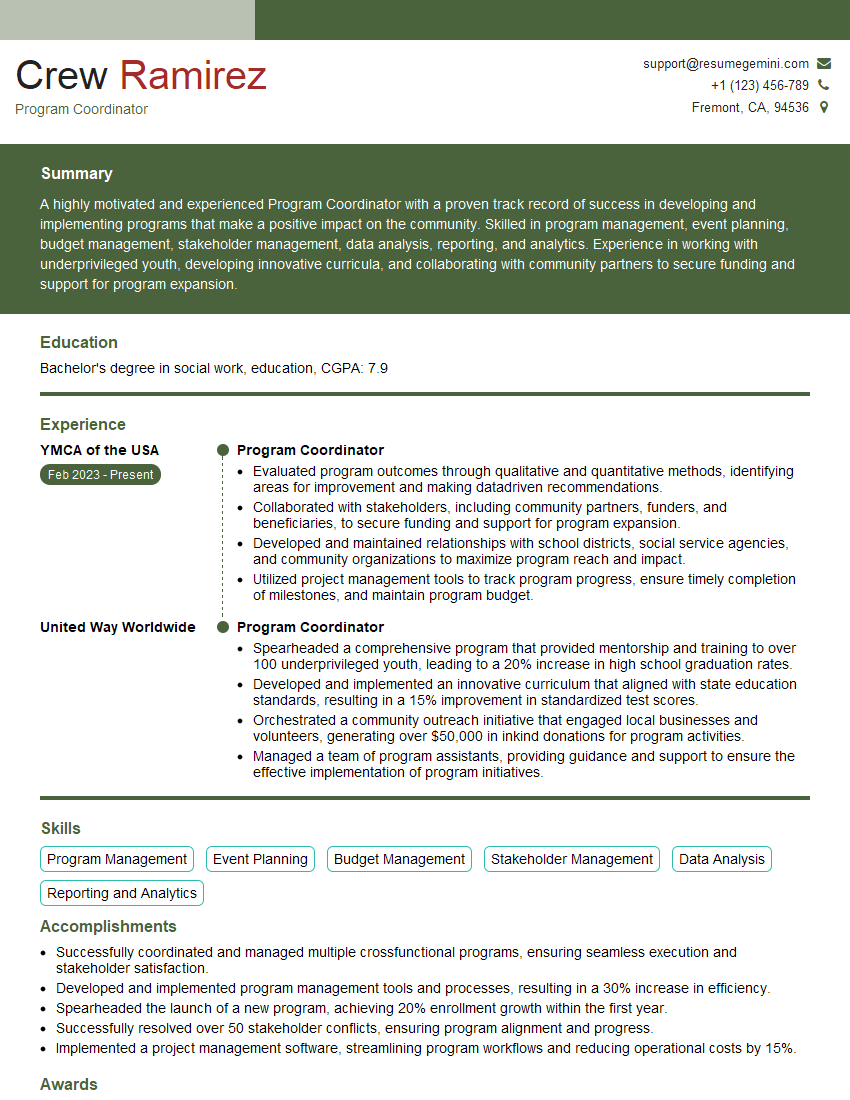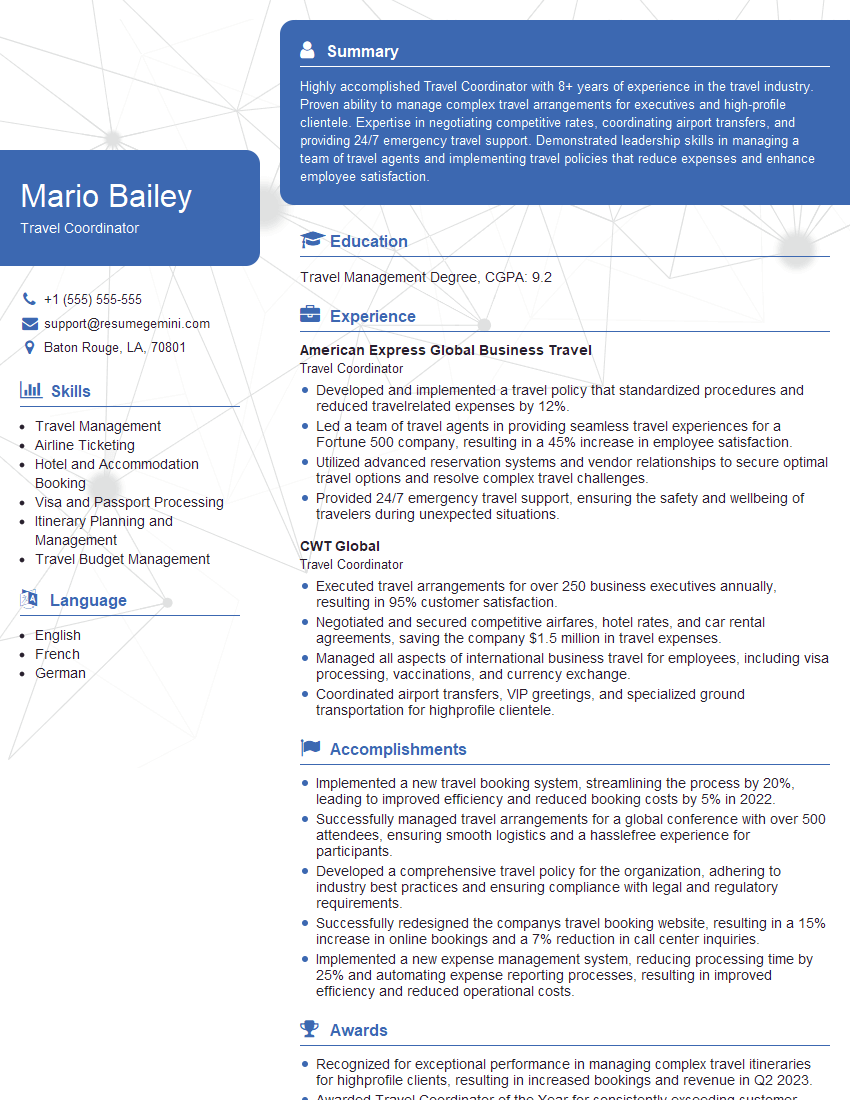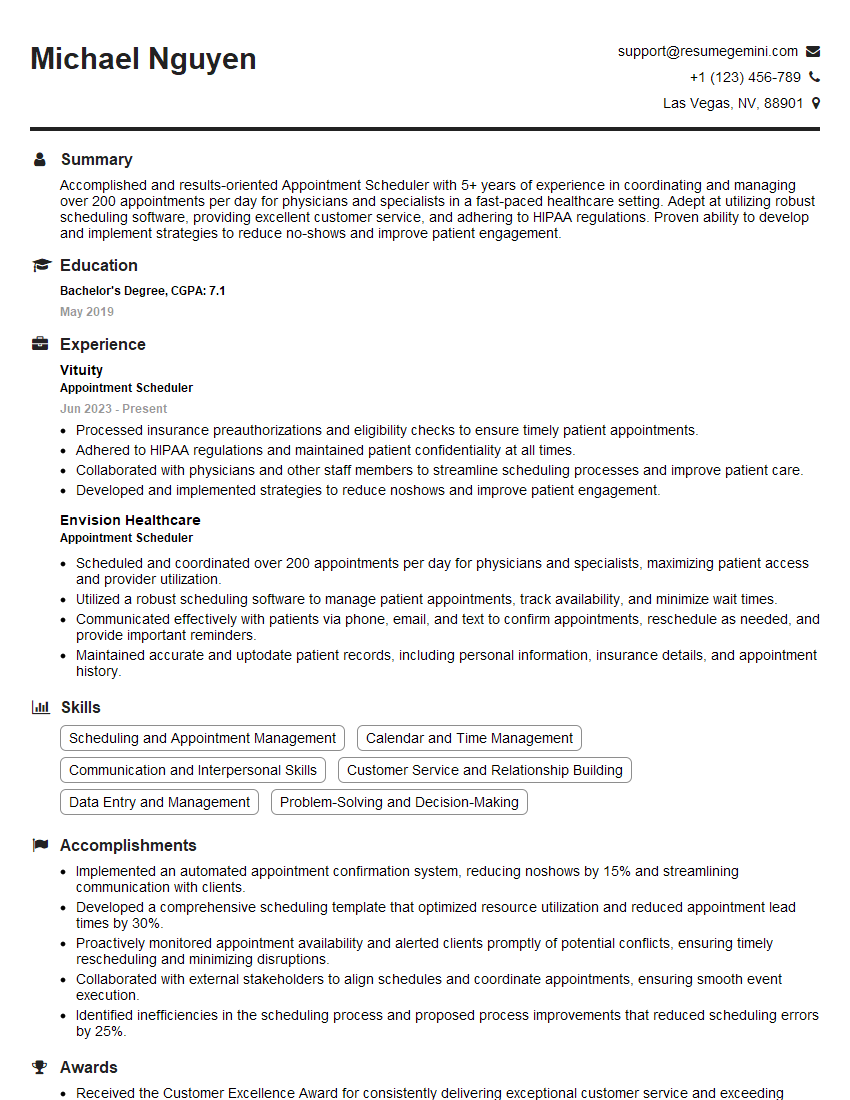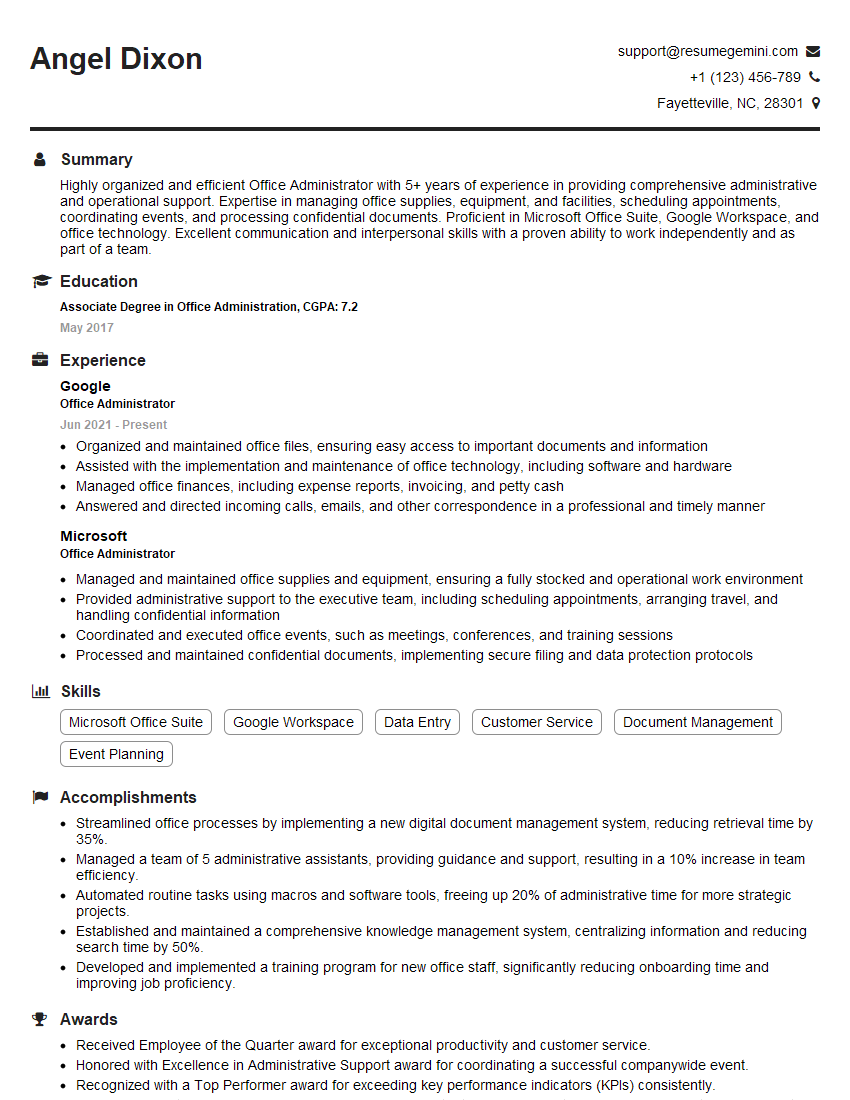Every successful interview starts with knowing what to expect. In this blog, we’ll take you through the top Meeting Planning and Scheduling interview questions, breaking them down with expert tips to help you deliver impactful answers. Step into your next interview fully prepared and ready to succeed.
Questions Asked in Meeting Planning and Scheduling Interview
Q 1. Describe your experience managing complex meeting schedules.
Managing complex meeting schedules requires a systematic approach combining organizational skills, technological proficiency, and a keen understanding of individual needs. My experience involves juggling numerous calendars, diverse time zones, and often conflicting priorities. I’ve successfully managed schedules for teams ranging from small project groups to large-scale cross-functional initiatives, often coordinating dozens of meetings weekly. This involves proactively identifying potential conflicts, suggesting alternative times, and using collaborative scheduling tools to ensure everyone is informed and on the same page.
For example, in my previous role, I managed the schedules for a global product launch team spread across three continents. I utilized a centralized calendar system, regularly monitored potential clashes, and proactively communicated schedule changes to mitigate disruptions. My process involved regularly reviewing calendars, identifying potential overlaps, and working collaboratively to find optimal times for all parties involved. This often involved creative scheduling, such as utilizing early morning or late evening slots to accommodate different time zones.
Q 2. How do you prioritize conflicting meeting requests?
Prioritizing conflicting meeting requests requires careful consideration of several factors: urgency, importance, attendee availability, and overall project impact. I employ a prioritization matrix, weighing these factors to determine which meetings need to be scheduled first. I begin by identifying the most time-sensitive or critical meetings. Then, I work backwards from there, scheduling meetings based on their priority level, ensuring critical meetings are accommodated first.
For instance, if I have a critical project deadline looming, a meeting focused on addressing that deadline will take precedence over a less urgent team update. I also consider the availability of key stakeholders and try to accommodate their schedules as much as possible. Transparency is key; I communicate clearly with all parties involved about scheduling decisions, explaining the rationale behind any prioritization.
Q 3. What software or tools do you utilize for meeting planning and scheduling?
My experience encompasses a wide range of scheduling tools, and my choice depends on the context. For smaller teams or ad-hoc meetings, Google Calendar is a highly effective and readily available tool. Its integration with other Google Workspace applications ensures seamless workflow. For larger organizations or projects requiring more sophisticated features, I’ve successfully utilized tools like Microsoft Outlook, scheduling features within project management platforms (Asana, Monday.com), and dedicated scheduling platforms like Calendly. Each tool provides a unique set of benefits, and I select the most appropriate based on the project needs and team size.
For example, Calendly excels at automating the scheduling process by allowing attendees to self-schedule based on the availability of the organizer. This reduces the back-and-forth communication required for finding a suitable time. Microsoft Outlook’s robust features, on the other hand, are useful when dealing with a complex web of inter-dependent meetings and resource allocation.
Q 4. Explain your process for confirming meeting attendees and sending reminders.
Confirming attendees and sending reminders is a crucial step in ensuring meeting success. My process involves sending out meeting invitations well in advance, ideally several days prior, using the chosen calendar application. The invitations explicitly state the meeting’s purpose, agenda, and any necessary pre-reading materials. Following the initial invitation, I send out automated reminders at regular intervals (e.g., one day before, one hour before) to enhance attendance. I also manually follow up with key individuals if I haven’t received confirmation within a reasonable timeframe.
For large meetings, I utilize email lists and distribution groups for efficient communication. For smaller meetings, individual emails ensure personalized interaction. The reminders include a concise summary of the meeting topic and any necessary logistical information.
Q 5. How do you handle last-minute meeting changes or cancellations?
Handling last-minute changes or cancellations requires swift action and clear communication. My approach involves immediately updating the meeting invite with the revised information, sending a brief follow-up notification to all attendees to inform them of the change, and providing a clear explanation for the alteration. For cancellations, I ensure all attendees are notified promptly and the meeting is removed from the calendar to prevent confusion. If a meeting needs to be rescheduled, I use the same collaborative scheduling methods as the initial booking to find a new time that works for all participants.
For example, if a key stakeholder is unexpectedly unavailable, I’ll immediately notify the attendees, propose alternative times, and work to reschedule the meeting as quickly as possible while keeping everyone informed. Transparency is paramount to mitigating any negative impact caused by unforeseen circumstances.
Q 6. Describe a time you had to reschedule a meeting due to unforeseen circumstances.
In a previous project, we were preparing for a critical client presentation. The day before the presentation, the main presenter fell ill. I immediately sprang into action. First, I contacted all attendees to inform them of the situation and the need to reschedule. Second, I identified a suitable replacement presenter among the team members who possessed adequate knowledge of the material. Third, I worked with the substitute presenter to prepare for the presentation, ensuring they were comfortable and well-informed. Finally, I communicated the new schedule and the necessary adjustments to the client, expressing our sincere apologies for the unexpected change. The client was understanding, and the rescheduled meeting proceeded successfully.
Q 7. How do you ensure all meeting materials are prepared and distributed in advance?
Ensuring all meeting materials are prepared and distributed in advance is crucial for a productive and efficient meeting. My process begins with creating a clear agenda, outlining the meeting’s objectives, topics for discussion, and expected outcomes. I then gather all necessary materials – presentations, reports, data, or any other relevant documentation – and consolidate them into a single, easily accessible location, often a shared drive or collaborative online platform. These materials are distributed to attendees well in advance, typically at least 24 hours prior, allowing ample time for review and preparation.
For example, I would create a central folder on a shared drive containing the presentation slides, supporting documents, and a clear agenda. I would then send out a link to this folder along with the meeting invitation. This approach ensures everyone has access to the necessary information and can come prepared for a focused and productive discussion.
Q 8. What strategies do you use to minimize meeting disruptions?
Minimizing meeting disruptions requires a proactive and multi-faceted approach. It’s about setting clear expectations and establishing a productive environment from the outset. Think of it like orchestrating a well-rehearsed symphony – every instrument (attendee) needs to know their part and play it effectively.
Clear communication before the meeting: Distribute the agenda well in advance, outlining objectives and expected contributions. This preemptive communication reduces confusion and off-topic discussions.
Establishing ground rules: At the start of the meeting, briefly review expectations for participation, such as muting microphones when not speaking (for virtual meetings) or respecting speaking time. This sets a tone of professionalism and focus.
Time management is key: Sticking to the agenda and allotted time for each item is crucial. A designated timekeeper can help ensure discussions stay on track. I often use a timer visible to all participants.
Addressing disruptions promptly and politely: If side conversations or unrelated topics arise, gently redirect the conversation back to the agenda. Maintaining a respectful yet firm approach is essential.
Technology checks: For virtual meetings, conducting a brief technology check beforehand ensures that everyone can access and use the platform effectively, avoiding technical glitches during the meeting.
Q 9. How do you manage international time zones when scheduling meetings?
Managing international time zones for meetings demands careful planning and consideration. It’s like navigating different time zones on a global map – you need to know where everyone is and adjust accordingly. I utilize several strategies:
Time zone conversion tools: I rely heavily on online tools and apps that automatically convert time zones, ensuring accuracy and eliminating the risk of scheduling errors. This ensures everyone understands the meeting time in their local time.
Polls and surveys: Before scheduling, I use polls or surveys to gather participants’ availability across different time zones. This data-driven approach allows me to find a time slot that works best for the majority.
Meeting duration: I often opt for shorter meetings to minimize the burden on attendees in different time zones. A shorter, focused meeting is more productive than a long, drawn-out one.
Recording and sharing: For participants who cannot attend due to scheduling conflicts, I record the meeting and share it later with appropriate notes and action items.
Rotating time zones: For recurring meetings, I consider rotating the meeting time to accommodate different time zones over time to ensure equitable distribution of inconvenience.
Q 10. How do you ensure meeting agendas are effective and relevant?
Effective and relevant meeting agendas are the cornerstone of a productive meeting. Think of it as a roadmap – it guides the conversation and keeps everyone focused. I create agendas with the following in mind:
Clearly defined objectives: The agenda should clearly state the meeting’s purpose and desired outcomes. What needs to be achieved by the end of the meeting?
Specific topics and time allocations: Each agenda item should be clearly defined, with a specific time allocated to ensure discussions don’t overrun.
Pre-reading materials: For complex topics, I often provide pre-reading materials, allowing participants to come prepared and engage more effectively.
Actionable items: The agenda should include specific action items that will be discussed and assigned during the meeting.
Review and updates: I regularly review and update the agenda based on feedback and changes in priorities to ensure its ongoing relevance.
Q 11. What techniques do you employ to manage meeting minutes effectively?
Effective management of meeting minutes requires a systematic approach. Think of it like creating a detailed record of a meeting’s proceedings, ensuring key information is easily accessible later. My process includes:
Real-time note-taking: I take notes during the meeting, capturing key decisions, action items, and assignments.
Clear and concise language: The minutes should be written in clear and concise language, avoiding jargon and technical terms unless absolutely necessary.
Distribution: I distribute the minutes promptly after the meeting, ensuring all attendees have access to the record.
Action item tracking: I include a section to track action items, assigning owners and deadlines.
Version control: For recurring meetings, I maintain version control to track changes over time.
Digital storage: I utilize a digital storage system for easy access and searchability.
Q 12. How do you handle conflicts between meeting participants’ schedules?
Handling schedule conflicts among meeting participants requires a flexible and diplomatic approach. It’s like solving a complex scheduling puzzle – you need to find the optimal time that works for as many people as possible. My strategies include:
Utilizing scheduling tools: I leverage online scheduling tools that allow participants to select their available times, automatically finding common slots.
Compromise and negotiation: When conflicts arise, I facilitate discussions and find a time that suits the majority, potentially involving some compromises.
Alternative meeting formats: If a single time slot is impossible, I consider alternative formats, such as shorter meetings, asynchronous communication, or breakout sessions.
Prioritization: For crucial meetings, I prioritize finding a time that accommodates key participants, even if it means some compromises.
Clear communication: Throughout the process, I maintain clear and open communication with all participants, keeping them informed of any changes or decisions.
Q 13. Describe your experience with virtual meeting platforms.
My experience with virtual meeting platforms is extensive. I’m proficient in using a variety of platforms, including Zoom, Microsoft Teams, Google Meet, and WebEx. I understand the nuances of each platform and can effectively leverage their features for optimal meeting efficiency. For example, I utilize features such as screen sharing, breakout rooms, polls, and chat functions to enhance collaboration and engagement.
Beyond basic functionality, I am adept at troubleshooting technical issues that may arise during virtual meetings. I can quickly address problems with audio, video, or screen sharing, minimizing disruptions to the flow of the meeting. I also understand the importance of selecting the appropriate platform based on the meeting’s size, complexity, and participants’ technical capabilities.
Q 14. How do you ensure accessibility for all attendees during meetings?
Ensuring accessibility for all attendees during meetings is paramount. This is about making the meeting inclusive and accommodating the needs of every participant. My approach incorporates:
Providing meeting materials in accessible formats: This includes providing documents in formats like Word, PDF, and plain text, ensuring compatibility with screen readers and assistive technologies.
Captioning and transcription: For virtual meetings, I utilize automatic captioning and, when necessary, professional transcription services to accommodate hearing-impaired attendees.
Clear and concise communication: I use clear and concise language, avoiding jargon, and providing visual aids when necessary.
Alternative communication methods: I offer alternative communication methods such as email or phone for those who may have difficulty participating in the meeting itself.
Accessible meeting locations: For in-person meetings, I ensure the location is physically accessible, with appropriate facilities for those with mobility impairments.
Q 15. What strategies do you use to track meeting attendance and outcomes?
Tracking meeting attendance and outcomes is crucial for evaluating effectiveness and improving future meetings. My strategy involves a multi-pronged approach leveraging both technology and manual processes.
Attendance Tracking: I utilize meeting invitation systems (like Outlook or Google Calendar) that automatically record RSVPs. For in-person meetings, I often use a sign-in sheet or a dedicated attendance tracking app. This data provides a clear picture of who attended and who was absent.
Outcome Tracking: I ensure clear meeting agendas are distributed beforehand, outlining specific objectives. During the meeting, I take detailed minutes, documenting key decisions, action items, and assigned owners. Post-meeting, I circulate these minutes for review and confirmation. For more complex meetings, I might use a collaborative document like a Google Doc or a project management tool like Asana to track action items and their progress.
Data Analysis: After several meetings, I analyze attendance data to identify trends (e.g., consistently low attendance for certain types of meetings). This helps inform adjustments to meeting frequency, time, or format. Similarly, I review action item completion rates from the meeting minutes to assess the effectiveness of the meetings in achieving their stated objectives.
For example, in a recent project, tracking showed consistently low attendance at weekly status updates. Analyzing the feedback, we shifted to bi-weekly updates with a more focused agenda, resulting in higher attendance and increased efficiency.
Career Expert Tips:
- Ace those interviews! Prepare effectively by reviewing the Top 50 Most Common Interview Questions on ResumeGemini.
- Navigate your job search with confidence! Explore a wide range of Career Tips on ResumeGemini. Learn about common challenges and recommendations to overcome them.
- Craft the perfect resume! Master the Art of Resume Writing with ResumeGemini’s guide. Showcase your unique qualifications and achievements effectively.
- Don’t miss out on holiday savings! Build your dream resume with ResumeGemini’s ATS optimized templates.
Q 16. How do you contribute to a productive and positive meeting environment?
Creating a productive and positive meeting environment requires careful planning and facilitation. My approach focuses on:
Clear Agenda and Purpose: I ensure that every meeting has a well-defined purpose, a clear agenda shared in advance, and a designated time limit. This ensures everyone understands the meeting’s objective and can prepare accordingly.
Active Participation: I encourage active participation from all attendees by posing open-ended questions, fostering a respectful dialogue, and ensuring everyone has an opportunity to contribute. I actively manage discussions to prevent them from going off-topic.
Constructive Communication: I establish ground rules for respectful and constructive communication. This includes active listening, avoiding interruptions, and focusing on solutions rather than blame.
Time Management: I meticulously adhere to the allotted time, ensuring that the meeting stays on track and concludes within the scheduled timeframe. This shows respect for everyone’s time.
Technology Proficiency: I ensure all necessary technology is working properly beforehand and have backup plans in place if needed. This eliminates technological disruptions that can derail a meeting.
For instance, in a recent brainstorming session, I used a visual collaboration tool to facilitate idea generation and keep track of the session’s key themes. This made the session engaging and ensured that all ideas were captured effectively.
Q 17. Describe your experience with booking meeting rooms and related resources.
My experience with booking meeting rooms and related resources encompasses various methods and tools. I’m proficient in using online booking systems like those integrated with Outlook or Google Calendar, as well as dedicated room reservation software commonly used in larger organizations. I also have experience with manually reserving rooms through facility management teams.
My process typically involves:
Identifying Requirements: Determining the necessary room size, technology requirements (projector, whiteboard, etc.), and catering needs.
Checking Availability: Using the appropriate booking system to check the availability of suitable rooms and resources.
Making Reservations: Securing the reservation, confirming details, and adding any relevant notes, such as special instructions for setup.
Confirmation and Follow-up: Sending out confirmations to attendees and confirming the reservation with the facilities team close to the meeting date.
I’ve successfully booked rooms for a wide range of meetings, from small team discussions to large-scale conferences, demonstrating adaptability to different needs and environments. My experience extends to managing resource conflicts and finding alternative solutions when preferred rooms are unavailable.
Q 18. How do you handle requests for ad-hoc meetings outside the usual schedule?
Handling ad-hoc meeting requests requires a flexible yet structured approach. My process usually begins with understanding the urgency and purpose of the meeting.
Assess Urgency: If it’s a truly urgent matter requiring immediate attention, I prioritize finding an available time slot, potentially even outside of normal working hours if necessary.
Check Availability: I quickly check available resources, including meeting rooms and attendee availability, using both online calendars and informal communication.
Suggest Alternatives: If an immediate in-person meeting isn’t possible, I propose alternatives, like a quick phone call, a virtual meeting using tools like Zoom or Teams, or rescheduling for a more suitable time.
Document the Meeting: Even for short, informal meetings, I’ll make brief notes of key decisions or action items to ensure follow-up.
For example, I recently helped coordinate an emergency meeting during the evening to address a critical production issue. By quickly assessing the situation and leveraging video conferencing, we resolved the problem swiftly and minimized disruption.
Q 19. What is your experience with budget management related to meeting planning?
Budget management in meeting planning is crucial for ensuring cost-effectiveness. My experience includes tracking expenses, negotiating rates, and making informed decisions to optimize spending.
Budget Allocation: I work with stakeholders to establish a clear budget for each meeting, considering various factors such as venue costs, catering, materials, and technology.
Cost Tracking: I meticulously track all expenses related to the meeting, including invoices and receipts. I utilize spreadsheets or specialized project management tools to monitor spending against the budget.
Negotiation and Cost Savings: I actively negotiate with vendors to secure favorable rates for venue rentals, catering, and other services. I explore cost-effective alternatives, such as using existing office spaces or opting for simpler catering options.
Reporting and Analysis: I prepare regular budget reports that show actual versus planned spending, highlighting any variances and potential areas for improvement.
For instance, in planning a large offsite meeting, I negotiated a discounted rate with a local hotel by booking rooms well in advance and opting for a simpler catering package, ultimately saving the company a significant amount of money.
Q 20. Explain your process for evaluating the effectiveness of meetings.
Evaluating meeting effectiveness involves a multi-faceted approach that goes beyond simply measuring attendance. My process considers several key aspects:
Pre-Meeting Objectives: I refer back to the pre-defined objectives outlined in the meeting agenda. Did the meeting successfully achieve those goals?
Action Item Completion: I track the completion rate of action items assigned during the meeting. A low completion rate may indicate issues with delegation, clarity, or feasibility.
Feedback Collection: I gather feedback from attendees through post-meeting surveys or informal discussions. This feedback provides insights into the meeting’s effectiveness and areas for improvement.
Outcome Measurement: I assess the tangible outcomes of the meeting, such as decisions made, progress achieved, or problems solved. This might involve reviewing subsequent project progress or sales figures.
Time Efficiency: Was the allocated time used effectively? Did the meeting achieve its objectives within the set time frame?
By analyzing this data, I can identify trends and make data-driven improvements to future meetings. For example, consistently low feedback scores on engagement might prompt a review of the meeting format or facilitation style.
Q 21. How do you use data analytics to improve meeting planning processes?
Data analytics plays a significant role in improving meeting planning processes. By analyzing meeting data, I can identify trends, predict potential issues, and optimize future meetings.
Attendance Patterns: Analyzing attendance data from past meetings reveals trends in attendance rates for different types of meetings, allowing for adjustments to scheduling or meeting formats.
Action Item Completion Rates: Tracking the completion rate of action items provides insights into task delegation, follow-up processes, and the overall effectiveness of assigned responsibilities.
Meeting Duration: Analyzing meeting lengths reveals potential inefficiencies that can be addressed by improving meeting agendas and facilitation techniques.
Feedback Analysis: Analyzing feedback data allows for identifying areas of strength and weakness in the meeting process and helps tailor future meetings to be more effective.
Technology Usage: Analyzing data from virtual meeting platforms can reveal optimal tools and technologies for collaboration and communication.
For example, by analyzing data, I discovered a correlation between longer meeting durations and lower action item completion rates. This led to a company-wide initiative to implement time-boxing techniques and more focused agendas to improve efficiency.
Q 22. How familiar are you with different meeting formats and their best practices?
I’m highly familiar with a wide range of meeting formats, each with its own best practices. For instance, a brainstorming session thrives on open discussion and creative idea generation, ideally facilitated with visual aids like whiteboards or digital collaboration tools. In contrast, a project status update meeting requires a structured agenda, clear reporting of progress, and assigned action items. A training session might necessitate interactive exercises and practical demonstrations. My experience encompasses:
- Brainstorming sessions: Utilizing techniques like mind mapping and round-robin to foster participation and capture diverse ideas. I always ensure a safe space where participants feel comfortable sharing even unconventional thoughts.
- Project status update meetings: Employing a standardized agenda, with time allocated for each team member’s report, ensuring concise updates and efficient problem-solving.
- Training sessions: Designing interactive sessions incorporating quizzes, group activities, and real-world case studies for better knowledge retention.
- Formal presentations: Preparing presentations that incorporate clear visuals and a strong narrative, ensuring engagement with a concise and impactful message. I always consider the audience’s prior knowledge and tailor the content accordingly.
Beyond these, I’m adept at adapting to less common formats, like design thinking workshops or retrospectives, ensuring the chosen format aligns perfectly with the meeting’s objective.
Q 23. Describe your approach to managing confidential meeting information.
Managing confidential meeting information requires a multi-layered approach, prioritizing security at every stage. This includes:
- Secure Meeting Invitations: I only use secure platforms to distribute meeting invitations, avoiding the use of generic email addresses and ensuring all invitees have appropriate access permissions.
- Controlled Access: For sensitive discussions, I limit participation to only those with a need-to-know, utilizing password protection or other access control measures.
- Data Encryption: If sensitive documents are shared, I ensure that they are encrypted either through platform capabilities or dedicated encryption software.
- Secure Meeting Environments: I choose meeting locations carefully, prioritizing private rooms or secure online platforms to prevent eavesdropping.
- Secure Document Disposal: After the meeting, any physical documents are securely shredded, and digital documents are deleted from all devices.
- Confidentiality Agreements (when necessary): For highly sensitive topics, I’d recommend utilizing confidentiality agreements with attendees before the meeting.
For example, during a meeting discussing a pending acquisition, I would ensure all attendees signed a non-disclosure agreement (NDA) beforehand and only distribute sensitive information through encrypted channels.
Q 24. What measures do you take to ensure compliance with company policies related to meetings?
Compliance with company policies is paramount in my approach to meeting planning. This involves:
- Adhering to meeting recording policies: I always inform participants of any recording, obtain consent if necessary, and ensure recordings are stored securely and comply with data privacy regulations.
- Following expense reporting guidelines: I meticulously track all meeting-related expenses, ensuring that they adhere to company’s reimbursement policies.
- Respecting diversity and inclusion policies: I create inclusive meeting environments that encourage participation from all attendees, regardless of background or experience.
- Understanding and applying data privacy regulations: All communications and documentation comply with GDPR, CCPA, or other relevant privacy laws and company policies.
- Regularly reviewing and updating my processes: I stay abreast of any changes to company policies to maintain compliance.
For instance, if a company policy mandates approval for expenses exceeding a certain amount, I ensure all such expenses are approved before incurring them. Similarly, if recording policies require specific consent mechanisms, I implement them diligently.
Q 25. How do you adapt your meeting planning approach based on the audience and purpose?
Adaptability is key. My approach changes significantly depending on the audience and purpose. For a senior leadership team, a concise presentation with key performance indicators (KPIs) is sufficient. However, for a team brainstorming session, an open, collaborative environment with ample time for discussion is essential. Here’s how I adapt:
- Audience Analysis: I assess the audience’s technical expertise, interests, and expectations before finalizing the meeting agenda and materials.
- Purpose Definition: A clear understanding of the meeting’s purpose – whether it’s decision-making, problem-solving, or information sharing – guides the format and content.
- Content Tailoring: I modify the complexity and depth of information based on the audience’s knowledge level.
- Interaction Style: The level of audience interaction varies. Some meetings require significant participation, while others might be primarily information-delivery focused.
For example, when presenting a technical proposal to a non-technical executive team, I use simple language, avoiding jargon and emphasizing visual aids.
Q 26. How do you handle disagreements among meeting participants?
Disagreements are inevitable in meetings. My approach focuses on facilitating constructive conflict resolution:
- Active Listening: I ensure everyone gets a chance to express their views without interruption.
- Neutral Facilitation: I act as a neutral facilitator, guiding the discussion and ensuring all perspectives are heard and respected.
- Collaborative Problem-Solving: I encourage participants to find common ground and work towards a mutually acceptable solution.
- Summarizing and Clarifying: I summarize points of agreement and disagreement to ensure everyone’s on the same page.
- Decision-Making Process: A clear decision-making process is crucial, whether it’s voting, consensus-building, or delegation to a smaller group.
If the disagreement is too intense or involves deeply entrenched positions, I might suggest a follow-up meeting with smaller groups or involve a mediator to help resolve the issue.
Q 27. Describe a situation where you had to overcome a challenge during meeting planning.
During the planning of a large-scale international conference, a major sponsor unexpectedly pulled out just three weeks before the event. This left a significant funding gap and threatened the conference’s viability. I immediately:
- Assessed the situation: I quantified the funding shortfall and its potential impact on the conference.
- Developed contingency plans: I explored options such as reducing the event’s scale, negotiating with vendors for reduced costs, and seeking alternative sponsors.
- Communicated proactively: I informed all stakeholders, including attendees and potential sponsors, of the situation and the mitigation strategies.
- Secured alternative funding: Through vigorous networking and proposal revisions, we successfully secured funding from several smaller sponsors. We also secured some in-kind donations which reduced our costs.
- Adjusted the plan: We slightly downscaled certain aspects of the event to align with the revised budget.
Ultimately, the conference was a success, although it required swift action, creative problem-solving, and effective communication.
Q 28. What are your salary expectations for this role?
My salary expectations for this role are in the range of [Insert Salary Range] per year. This is based on my experience, skills, and the responsibilities outlined in the job description. I am open to discussing this further based on a detailed review of the compensation and benefits package.
Key Topics to Learn for Meeting Planning and Scheduling Interview
- Understanding Meeting Objectives: Defining clear goals and desired outcomes before scheduling, ensuring every meeting has a purpose.
- Time Zone Management & International Scheduling: Accurately calculating time differences and selecting optimal meeting times across multiple time zones for global teams.
- Calendar Management & Software Proficiency: Mastering scheduling tools like Outlook, Google Calendar, or specialized meeting scheduling software; demonstrating efficient calendar management techniques.
- Resource Allocation & Booking: Securing necessary meeting rooms, technology (video conferencing, presentations), and catering, optimizing resource utilization.
- Meeting Preparation & Logistics: Distributing agendas, preparing materials, confirming attendee participation, and managing pre-meeting communication effectively.
- Conflict Resolution & Scheduling Optimization: Identifying and resolving scheduling conflicts, finding optimal meeting times for all participants, demonstrating problem-solving skills.
- Post-Meeting Follow-up: Distributing meeting minutes, action items, and follow-up communications, ensuring accountability and progress tracking.
- Communication & Collaboration: Effectively communicating with stakeholders, coordinating with various teams, and maintaining excellent interpersonal skills.
- Data Analysis & Reporting: Tracking meeting attendance, participation, and outcomes to provide insightful data for improving future meetings.
Next Steps
Mastering Meeting Planning and Scheduling is crucial for career advancement, demonstrating your organizational skills and ability to streamline workflows, leading to increased efficiency and productivity. An ATS-friendly resume is essential to showcase these skills effectively to potential employers. To significantly enhance your resume and improve your chances of landing your dream job, leverage the power of ResumeGemini. ResumeGemini provides a trusted platform for creating professional, impactful resumes, and we offer examples of resumes tailored specifically to Meeting Planning and Scheduling professionals to help guide you.
Explore more articles
Users Rating of Our Blogs
Share Your Experience
We value your feedback! Please rate our content and share your thoughts (optional).
What Readers Say About Our Blog
Hi, I’m Jay, we have a few potential clients that are interested in your services, thought you might be a good fit. I’d love to talk about the details, when do you have time to talk?
Best,
Jay
Founder | CEO
